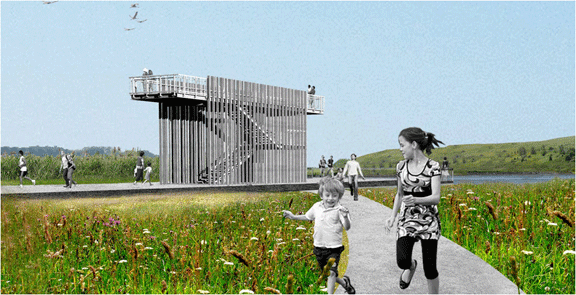A Salvaged Banksy Mural is Now on View in NYC
This unique Banksy mural goes up for auction on May 21st in NYC!


The Department of Parks & Recreation opened up 300 acres of the burgeoning Freshkills Park on Sunday for its fourth annual “Sneak Peak” – the one day a year the public gets to see what will one day be the world’s largest landfill-to-park conversion.
In anticipation of the Sneak Peak, dozens of park enthusiasts braved the chill last Monday evening atop the High Line to hear James Corner, the park’s master planner, and Eloise Hirsch of the Parks department discuss the park’s progress thus far and – much lengthier – its future.
As James Corner – also lead designer of the High Line – was quick to point out, Freshkills is a much different animal than the High Line. The most obvious difference is size: the High Line is a mile long and the width of two train tracks. At 2,200 acres, Freshkills is nearly three times the size of Central Park and, when complete, will be the city’s second-largest park after Pelham Bay Park in the Bronx.
But the difference Corner likes to draw attention to is time. Both conceived in 1999, the parks are at vastly different stages of development. Opened in phases in 2009, 2011 and finally, 2014, the High Line’s transformation of a dank industrial neighborhood has been rapid and remarkable. Freshkills has a playground and a couple of soccer fields to show for 13 years of planning and construction. But that is both a function of the park’s tricky legacy as a former landfill, and intentional on behalf of the designer.
Corner waxes poetic on the timelessness of “designing a process, not a place.” He compares the slow phasing in of landscapes and programs to lichen’s invasion of a host species. Freshkills is to be living, dynamic, never in a finished state. There is some rationale for this, putting aside the obvious challenge of funding a massive urban park all at once. Freshkills sits on 150 million pounds of waste – what was once the world’s largest landfill. As the mounds of trash decompose over time, they will deflate at an uneven rate. So a child visiting a hill at the site today could return as an adult to find nothing but a pimple of dirt.

Waste is not hospitable to the types of landscaping we desire in our parks. So crops are to be grown over the mounds, and then mowed into the soil every five months to create several inches of topsoil over a matter of years. Gas extraction wells will pop through at regular intervals to relieve the build-up of methane and carbon dioxide produced by the waste, which will then be sold to the local utility for conversion to fuel. A herd of goats was delivered recently to munch on invasive grass. Returning birds, turtles and dozens of other animals are proof of the ecosystem’s renewed health.
This is the process that excites Corner, even if he won’t be around to see the end result. (Freshkills isn’t expected to be fully built-out until at least 2036.) But Hirsch from the Parks department is much more anxious. She likes to draw attention to what the park is today. Hirsch wants to know, “how do we get the public interested beyond ‘that’s the park that will be done in 30 years’?”

Freshkill’s neighbors on Staten Island have been slow to accept the changes that are inevitable when the city’s second-largest park is taking shape in your backyard. So some of the park’s early chapters, including Schmul Playground and a landscaped bikeway along Richmond Avenue, have intentionally been rather timid gestures placed around the park’s fringes. Their aim is to draw locals in, and to convince them this is just another park. Eventually, biking, hiking and horseback riding should be commonplace. Trash barges will be reconfigured as floating gardens. The deeper you get into the park, the wilder. A bird-viewing tower will occupy the center.
Corner, who is originally from northern England, says the landscape reminds him of home. “There’s something ghostly and extraordinary about it,” he says. One of the mounds was formed primarily from debris extracted from the wreckage of the first World Trade Center. On this, Corner will build an earthwork reflecting the shapes of the towers on their sides. After a 20-minute ascent, visitors will be greeted with an unimpeded view of the Manhattan skyline. Here’s hoping that trash pile won’t deflate quite so quickly.

All images courtesy of James Corner Field Operations and City of New York Department of Parks & Recreation
Subscribe to our newsletter